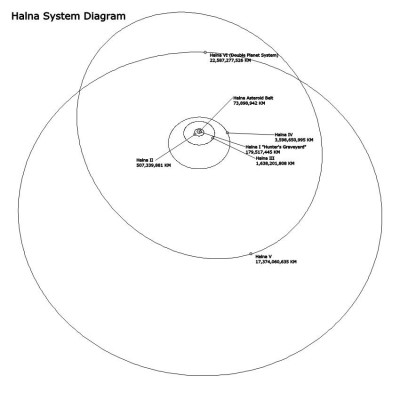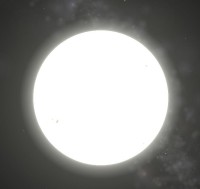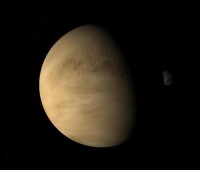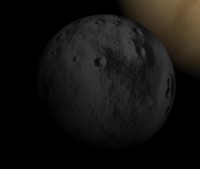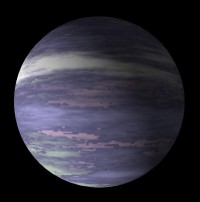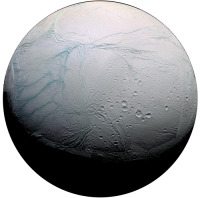Sidebar
Table of Contents
Halna
Halna is a star system located in the territory of the Yamatai Star Empire.
Star Data
- Stellar Age: 2.6 Billion Years
- Spectral Class: A7V
- Mass: 2.225 sol
- Radius: 1.896 sol
- Luminosity: 16 sol
Halna is a massive, stable class A main sequence star that gives off intense bluish-white light.
Halna Asteroid Belt
- Distance: 73,898,943 km
- Belt Width: 2,678,297 km
Description: The first anomaly in the star system is a small asteroid field at roughly 0.5 AU from the star. The asteroids in this field are composed of a wide variety of elements, giving indications that the masses are the remains of a planet or planets that once orbited where the field exists. The largest of the asteroids max out around ten miles in diameter, though the field is quite full so many asteroids break up and recombine with others as they orbit, leaving tracking individuals quite difficult.
The asteroid belt's unusual proximity to the star is a subject of speculation. One theory is that the field of debris was once another modestly-sized terrestrial planet that was pulverized into dust by a spectacular collision, or perhaps pulled apart by gravitational perturbations caused by its massive neighboring planets. Many of the asteroids in this belt appear to be in a degrading orbit spiralling slowing into the star itself, giving rise to the theory that the belt was at one time perhaps much larger, and many of its original components were ejected from the system.
There is still a small handful of undetonated ordnance left from Freespacer Massacre and Related Battles drifting through the belt. They are not common, and difficult to happen upon by accident. In YE 36, the Concordia Veil discovered a the remains of an independent Hikari Mining Ship that had been destroyed by one such stray warhead, killing all but two of the crew. The wreck is still there, its entire bow section blown to pieces, which now circle the wreck in an irregular cloud of debris that circles the remaining parts of the ship. The wreck itself is tumbling on all three axes, drifting away from one of the more massive asteroids. On its current course, it is expected to drift into the Halna star by YE 62, assuming it does not collide with another asteroid before then.
Halna I "Graveyard"
- Standard (Greenhouse)
- Distance: 179,517,445 km
- Radius: 11,131 km
- Gravity: 1.92G
- Orbit Period: 321.64 days
- Rotation: 33 hrs
- Climate: Infernal
- Mean Temp: 785K/512C
- Atmosphere: Very Dense (Suffocating, Lethally Toxic, and Corrosive)
- Atmospheric Composition: 78.4% carbon dioxide, 19.63% sulfur dioxide, 1.97% trace gasses
- Planetary Composition: 31.1% iron, 27.9% nickel, 23.9% magnesium, 11.6% silicon, 5.0% other metals, 0.4% other elements
- Water / Ice Index: 0
- Volcanic Activity: Moderate
- Tectonic Activity: Light
- Resource Value: Abundant
- Habitability Value: -2
Description: Link to article
Satellites (1)
Halna I.1 - The Black Moon
- Tiny (Rock)
- Distance: 327,393 km
- Radius: 2,080 km
- Gravity: 0.42G
- Orbit Period: 9.32 days (0.6997 eccentricity)
- Rotation: 8 hrs
- Climate: Infernal
- Mean Temp: 432K/159C
- Atmosphere: None
- Planetary Composition: 31.9% iron, 29.0% nickel, 10.8% carbon, 5.1% silicon, 4.2% other metals, 2.3% other elements
- Water / Ice Index: 0
- Volcanic Activity: None
- Tectonic Activity: Light
- Resource Value: Average
- Habitability Value: +0
Description: Link to article
Halna II "Agatha"
- Small Gas Giant
- Distance: 507,339,881 km
- Radius: 33,757 km
- Gravity: 1.11G
- Orbit Period: 4.19 years
- Rotation: 418.2 hrs
- Mean Temp: 232K/-41C
Description: This modest-sized bluish-purple gas giant is the primary source of cheap hydrogen fuel and antimatter derivatives for the local colony, scooped from its upper atmosphere by independently contracted vessels. Fuel skimming is a delicate and dangerous process due to the planet's intense magnetic field and torrential atmospheric phenomenon, so only the most reckless or desperate pilots typically agree to such an operation. However, because there are always dozens of pilots that fit such a bill, the premiums paid for any material brought back to the Black Moon are usually fairly low.
The planet's powerful magnetic field and radiation keeps its moons blasted free of any traces of atmosphere, and makes mining operations on any of them too expensive to be profitable.
Satellites (9)
Halna II.1
- Small body
Halna II.2
- Small (Rock)
- Distance: 48,002 km
- Radius: 2,860 km
- Gravity: 0.36G
- Orbit Period: 0.48 days
- Rotation: 0 hrs
- Climate: Cool
- Mean Temp: 281K/8C
- Atmosphere: Very Thin (No/Negligible Composition)
- Water / Ice Index: 0
- Volcanic Activity: Moderate
- Tectonic Activity: None
- Resource Value: Poor
- Habitability Value: +0
Halna II.3
- Tiny (Rock)
- Distance: 86,688 km
- Radius: 2,055 km
- Gravity: 0.16G
- Orbit Period: 0.86 days
- Rotation: 0 hrs
- Climate: Frozen
- Mean Temp: 244K/-29C
- Atmosphere: Trace (No/Negligible Composition)
- Water / Ice Index: 0
- Volcanic Activity: None
- Tectonic Activity: None
- Resource Value: Very Poor
- Habitability Value: +0
Halna II.4
- Tiny (Rock)
- Distance: 102,554 km
- Radius: 721 km
- Gravity: 0.1G
- Orbit Period: 1.03 days
- Rotation: 0 hrs
- Climate: Chilly
- Mean Temp: 275K/2C
- Atmosphere: None (No/Negligible Composition)
- Water / Ice Index: 0
- Volcanic Activity: None
- Tectonic Activity: None
- Resource Value: Poor
- Habitability Value: +0
Halna II.5
- Tiny (Rock)
- Distance: 289,297 km
- Radius: 134 km
- Gravity: 0.00G
- Orbit Period: 3.77 days
- Rotation: 0 hrs
- Climate: Very Cold
- Mean Temp: 253K/-20C
- Atmosphere: None (No/Negligible Composition)
- Water / Ice Index: 0
- Volcanic Activity: None
- Tectonic Activity: None
- Resource Value: Very Poor
- Habitability Value: +0
Halna II.6
- Tiny (Rock)
- Distance: 1,637,214 km
- Radius: 1,106 km
- Gravity: 0.24G
- Orbit Period: 44.31 days
- Rotation: 39 hrs
- Climate: Cold
- Mean Temp: 262K/-11C
- Atmosphere: None (No/Negligible Composition)
- Water / Ice Index: 0
- Volcanic Activity: Moderate
- Tectonic Activity: None
- Resource Value: Average
- Habitability Value: +0
Halna II.7
- Tiny (Rock)
- Distance: 2,118,589 km
- Radius: 471 km
- Gravity: 0.03G
- Orbit Period: 64.77 days
- Rotation: 47.3 hrs
- Climate: Very Cold
- Mean Temp: 254K/-19C
- Atmosphere: None (No/Negligible Composition)
- Water / Ice Index: 0
- Volcanic Activity: None
- Tectonic Activity: None
- Resource Value: Average
- Habitability Value: +0
Halna II.8
- Tiny (Rock)
- Distance: 3,557,313 km
- Radius: 3,229 km
- Gravity: 0.3G
- Orbit Period: 139.59 days
- Rotation: -24 hrs
- Climate: Chilly
- Mean Temp: 272K/-1C
- Atmosphere: Trace (No/Negligible Composition)
- Water / Ice Index: 0
- Volcanic Activity: Moderate
- Tectonic Activity: None
- Resource Value: Average
- Habitability Value: +0
Halna II.9
- Tiny (Rock)
- Distance: 5,988,492 km
- Radius: 641 km
- Gravity: 0.08G
- Orbit Period: 303.15 days
- Rotation: 38 hrs
- Climate: Cold
- Mean Temp: 262K/-11C
- Atmosphere: None (No/Negligible Composition)
- Water / Ice Index: 0
- Volcanic Activity: None
- Tectonic Activity: None
- Resource Value: Average
- Habitability Value: +0
Halna III
- Large (Ice)
- Distance: 1,638,201,808 km
- Radius: 8,325 km
- Gravity: 1.04G
- Orbit Period: 24.29 years
- Rotation: 43 hrs
- Climate: Frozen
- Mean Temp: 158K/-115C
- Atmosphere: Superdense (Suffocating and Highly Toxic)
- Water / Ice Index: 100
- Volcanic Activity: Heavy
- Tectonic Activity: Moderate
- Resource Value: Average
- Habitability Value: -2
Description: This planet is entirely shrouded in a thick, noxious atmosphere composed almost exclusively of helium and nitrogen. Its surface is a sheet of ice, predominantly made up of frozen “dirty water,” with fault lines and craggy ice mountain ranges crisscrossing its jagged surface. Violent cryovolcanoes constantly spew crystalline geysers of water vapor and molten rock that instantly freezes to shards of crystal upon entry into the atmosphere, capable of shredding anything softer than steel into ribbons upon contact. It is remarkably similar to Halna IV, its “sister” planet.
Satellites (2)
Halna III.1
- Small body
Halna III.2
- Tiny (Rock)
- Distance: 114,852 km
- Radius: 136 km
- Gravity: 0.02G
- Orbit Period: 3.71 days
- Rotation: 0 hrs
- Climate: Frozen
- Mean Temp: 150K/-123C
- Atmosphere: None (No/Negligible Composition)
- Water / Ice Index: 0
- Volcanic Activity: None
- Tectonic Activity: None
- Resource Value: Average
- Habitability Value: +0
Halna IV
- Large (Ice)
- Distance: 3,598,650,995 km
- Radius: 7,379 km
- Gravity: 0.93G
- Orbit Period: 79.09 years
- Rotation: 38 hrs
- Climate: Frozen
- Mean Temp: 125K/-148C
- Atmosphere: Superdense (Suffocating and Highly Toxic)
- Water / Ice Index: 64.93
- Volcanic Activity: Heavy
- Tectonic Activity: Heavy
- Resource Value: Average
- Habitability Value: -1
Description: This planet is entirely shrouded in a thick, noxious atmosphere composed almost exclusively of helium and nitrogen. Its surface is a sheet of ice, predominantly made up of frozen “dirty water,” with fault lines and craggy ice mountain ranges crisscrossing its jagged surface. Violent cryovolcanoes constantly spew crystalline geysers of water vapor and molten rock that instantly freezes to shards of crystal upon entry into the atmosphere, capable of shredding anything softer than steel into ribbons upon contact.
Its only notable difference from its sister planet Halna III is that it is markedly more tectonically active, with an even geologically younger and markedly more mountainous surface with almost no plains or level areas to speak of. Building a permanent structure on its unstable surface would be foolish.
Halna V
- Large (Ice)
- Distance: 17,374,060,635 km
- Radius: 3,624 km
- Gravity: 0.57G
- Orbit Period: 839.01 years
- Rotation: -11 hrs
- Climate: Frozen
- Mean Temp: 49K/-224C
- Atmosphere: Very Thin (Suffocating and Highly Toxic)
- Water / Ice Index: 28.5
- Volcanic Activity: Light
- Tectonic Activity: None
- Resource Value: Poor
- Habitability Value: +0
Description: A largely uninteresting ball of ice and rock with very mild cryovolcanism.
Halna VI
- Double Planet System
- Distance: 22,587,277,526 km
- Orbit Period: 1243.69 years
Halna VIa
- Large (Ice)
- Radius: 5,722 km
- Gravity: 0.9G
- Rotation: -42 hrs
- Climate: Frozen
- Mean Temp: 46K/-227C
- Atmosphere: Very Dense (Suffocating and Highly Toxic)
- Water / Ice Index: 84.95
- Volcanic Activity: Moderate
- Tectonic Activity: Moderate
- Resource Value: Average
- Habitability Value: +1
Description: A planet very similar to Halna III and IV, with a markedly more stable planetary surface.
Halna VIb
- Large (Ice)
- Radius: 4,978 km
- Gravity: 0.86G
- Rotation: 30 hrs
- Climate: Frozen
- Mean Temp: 46K/-227C
- Atmosphere: Superdense (Suffocating and Highly Toxic)
- Water / Ice Index: 83.91
- Volcanic Activity: Moderate
- Tectonic Activity: Light
- Resource Value: Average
- Habitability Value: +1
Description: A planet very similar to Halna III and IV, with a markedly more stable planetary surface.
| Map Locations | |
|---|---|
| Map to Use | Kikyo Sector |
| Map Display Name | Halna |
| Map Coordinates | 1694,1672 |
| Map Importance | Minor RP Location |
| Show label? | yes |
| Marker Anchor | Bottom Center |
| Places of the SARPiverse | |
|---|---|
| Place Categories | star system |
Page Tools
Terms of Service - Privacy Policy

